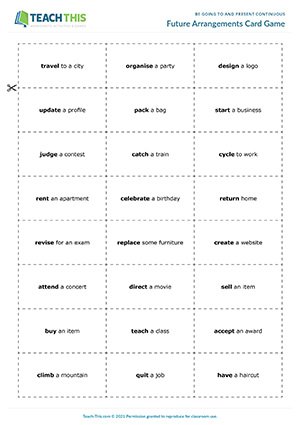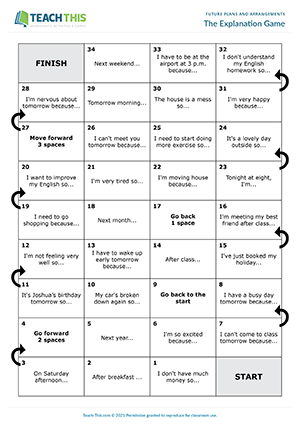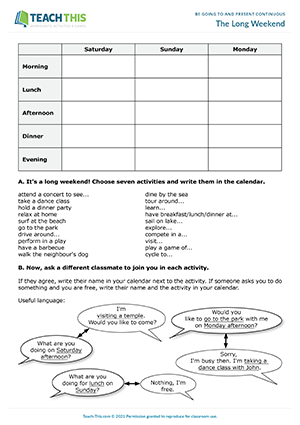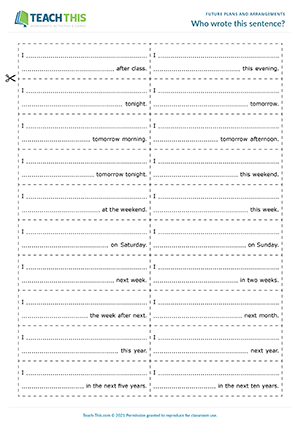

This be going to and present continuous speaking activity helps students practice asking and answering questions about future plans and arrangements. Students begin by going through the Are you. questions they need to ask to do the activity, e.g. 'Are you watching TV tonight?' Students then walk around the classroom and ask questions to their classmates about their future plans and arrangements. When a classmate answers 'Yes, I am' to a question, the student writes down their name and asks follow-up questions to gain more information. When everyone has finished, students give feedback to the class on what they found out by making sentences with be going to and the present continuous.



Here is a free present continuous for future plans activity to use with your students. Tell the students that it's the start of the summer holidays and that you need some people to help you prepare for next Sunday evening’s summer school fair. To help decide who will help you, students play a game where they have to find all four of their partner’s free periods in a diary of their plans for next week. In pairs, students then take turns asking their partner about their plans for next week using the present continuous, e.g. 'What are you doing on Wednesday afternoon?' Their partner looks at their diary for that day and time and replies by making a present continuous sentence, e.g. 'I’m working at the cafe.' The student then writes their partner's response in a blank diary. The first student to find all their partner’s free periods wins. The loser has to spend their free time with the other students helping the teacher prepare for the school fair!



In this comprehensive be going to and present continuous worksheet, students learn how to use the present continuous for fixed future plans and be going to for intended future plans. Students begin by reading a conversation about future plans and completing gaps with the correct form of the verbs in brackets. Next, students put the future plans from the conversation in the correct category, fixed future plans or intended future plans. Students then complete grammar rules for using be going to and the present continuous. Students then move on to use verbs from a box to complete be going to sentences and match situations to them. After that, students use prompts to create fixed future plans in the present continuous tense. Finally, students write about a fixed and an intended future plan of their own.



In this useful present continuous speaking activity, students practice making arrangements for next week. First, students think of eight leisure activities they would like to do and write them down anywhere in their schedules. Students then go around the class and find someone who is free to do each activity with them. Students must find a different person for each activity. When two students agree to do an activity together, they write each other's names and the time they have arranged to meet in the relevant place in their schedules. Students repeat the process until they have found someone for each leisure activity and completed their schedule with other arrangements. Finally, students tell the class about their arrangements for next week using the present continuous.



In this inventive present continuous game, students practice talking about future arrangements based on various topics. In groups, the first student picks up a card and lays it face-up on the table, e.g. travel to a city. The student then talks for 30 seconds about the future arrangement on the card using the present continuous, e.g. 'I'm travelling to Paris next week. I'm arriving on Monday morning. I'm staying at. ', etc. The first sentence the student says must use the verb in bold on the card and must follow the topic. Students must also use a different verb in each sentence. Students score one point for each present continuous sentence they make within the 30-second time frame. The next student then picks up a card, and so on. The student with the most points at the end of the game is the winner.



This productive be going to and present continuous speaking activity helps to review the difference between be going to for future plans and the present continuous for definite arrangements in the future. First, students complete a diary with ten activities they are going to do next week. Half the activities should include a definite time. In groups, students then try to find one person to do each activity with and make other arrangements to fill up their diary. They do this by asking other group members if they are free at certain times, e.g. 'Diego, are you free on Tuesday afternoon?' If a group member replies 'Yes, I am', the student invites them to do the activity shown at that day and time in their diary, e.g. 'I'm going to the park. Would you like to join?' If their partner agrees, the student writes their name next to the activity. The other student writes the activity, their partner's name and time if it's a definite arrangement in their diary. If a group member replies 'No, I'm not', the student gives a reason using be going to or the present continuous. Finally, groups give feedback to the class on their plans for next week.



In this free be going to and present continuous board game, students use prompts to give explanations about future plans and arrangements. Students take turns rolling the dice and moving their counter along the board. When a student lands on a square, they read the sentence or phrase and invent an ending by explaining their future plans or arrangements to the group using be going to or the present continuous, e.g. 'I don’t have much money, so I’m going to get a part-time job at the mall.' If you want to make the game harder, tell the students that they must talk for 30 seconds, so they produce several sentences based on the situation or topic. The other students in the group judge the student’s explanation and use of future forms. If the response is appropriate, the student stays on the square. If a student makes a mistake or cannot think of an explanation, they go back two spaces. The first student to reach the finish square wins the game.



In this communicative present continuous activity, students make arrangements and talk about them. In the activity, students also practice inviting, accepting and declining. First, students choose seven activities from the worksheet they would like to do over an upcoming long weekend and write them anywhere they like in a calendar. Students then go around the class and try to find a partner for each activity and get involved in other activities to fill up their calendar by making arrangements with each other for the long weekend. Students must find a different partner for each activity. The students who manage to fill up their entire calendar are the winners. Afterwards, students use the present continuous to give feedback to the class about their arrangements over the long weekend.



In this entertaining be going to and present continuous game, students complete sentences about their future plans and arrangements and then find out who wrote other sentences by asking yes/no questions. First, students complete sentences on cards with true information about their future plans or definite arrangements, fold up their sentences, and put them in a box. Next, all the students stand up and take one card each from the box. Students then find out who wrote each sentence by asking their classmates yes/no questions with be going to or the present continuous, e.g. 'Are you meeting a friend after class?' When a classmate answers 'Yes, I am', the student writes their name on the card, keeps it and takes another one from the box. If a classmate replies 'No, I'm not' or they didn't write the sentence, the student moves on to ask someone else. The student with the most sentences at the end is the winner.



In this fun be going to and present continuous board game, students talk about different future plans or arrangements for 30 seconds. Players take turns rolling the dice and moving their counter along the board. When a player lands on a square, they talk about the future plan or arrangement on the square for 30 seconds using either the present continuous or be going to as appropriate. The other group members listen and judge the player's response. If the player manages to talk about the topic for 30 seconds using the present continuous or be going to correctly, they stay on the square. If the player stops talking before the time is up or makes a grammar mistake, they go back two squares. The first player to reach the finish wins the game.